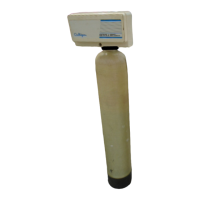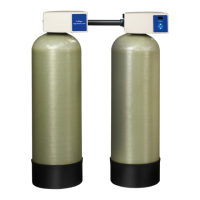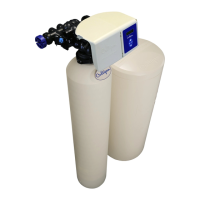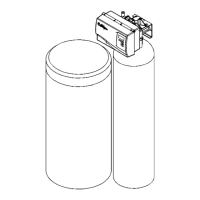22 Culligan® Series E2 Plus Reverse Osmosis
22 Cat. No. 01023094
NOTICE Replace the prefilter cartridges if they are discolored by iron.
NOTICE Because strong chemicals are used to clean the elements, maintenance cleaning is not recom-
mended. If the elements need to be cleaned frequently (more than twice a year), the pretreatment
may be inadequate. Obtain a current water analysis and test the Silt Density Index and the Total
Chlorine level of the water on-site to review what changes in pretreatment may be needed.
When cleaning is required, the type of material which is fouling the element should be identified, if possible. Refer to
Table 3 to determine the possible causes of the performance change.
Percent
Rejection
Flow
Low Normal High
Low Hardness Scale Hardness Scale (light) or Iron Membrane Damage
High Silt or Biofouling — Membrane Damage (light)
Table 3. Performance change possible causes.
For example, if the product flow is low but the percent rejection is normal, the likely causes of the problem are silt or
biofouling. Please note that if the product flow rate has increased (with no increase in temperature or pressure) the likely
reason is damage to the membrane, which cannot be repaired by cleaning.
Once the foulant has been identified, choose the recommended cleaning chemical(s) from Table 4.
Membrane Problem Cleaning Chemical
Hardness Scale Hydrochloric acid, phosphoric acid
Iron Hydrochloric acid, phosphoric acid
Silt Phosphoric acid and sodium hydroxide
Biofouling Phosphoric acid and sodium hydroxide
Table 4. Recommended membrane cleaning chemicals.
Because phosphoric acid can be used by itself or in combination with sodium hydroxide to clean almost all types of fou-
lants, it is generally recommended over hydrochloric acid when choosing a “stock” acid.
NOTICE Some municipal surface water supplies are treated with alum. Aluminum fouling results in low flow
and, occasionally, in low rejection. If aluminum fouling is suspected, use only hydrochloric acid.
Use a pH meter to prepare acid and caustic solutions, and to monitor pH changes as the solutions react with any foulants.
Materials required:
1. Solution tank (50 gallon capacity, minimum), to prepare and store the chemical solution.
2. Tank stand, to elevate solution tank to level above pump.
CAUTION! The bottom of the tank must be higher than the pump on the RO unit to prevent cavita-
tion of the pump when solution is drawn from the tank.
3. Tubing 1/2” O.D. to connect cleaning adapter ahead of Pre-filter.
4. A pH meter.
5. A pre-filter cartridge (P/N 00955004).
Before proceeding record the “NOW” values in Table 2.
